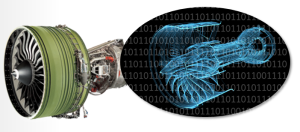Get ready for the age when every product will have a “digital twin” back at the manufacturer, a perfect copy of not just the product as it left the factory floor, but as it is functioning in the field right now. That will be yet another IoT game-changer in terms of my 4th IoT Essential Truth, “rethink products.”
Oh, and did I forget to mention that we’ll each have a personal body twin from birth, to improve our health?
For the first time we’ll really understand products, how they work, what’s needed to improve them, and even how they may be tweaked once they’re thousands of miles from the factory, to add new features, fix problems, and/or optimize efficiency.
Key to circular organizations
Even better, the twin can play a critical role in accomplishing my vision of new circular organizations (replacing obsolete hierarchies and linear processes), in which all relevant departments and functions (and even supply chain members, distribution networks and customers, where relevant) form a continuous circle with real-time IoT data as the hub). Think of the twin as one of those manifestations of the real-time data to which all departments will have simultaneous access.

GE Digital Twin visualization
I’ve often remarked how incredible it was that companies (especially manufacturers) were able to function as well as they did and produce products as functional as they were despite the inability to peek inside them and really understand their operations and/or problems. Bravo, industrial pioneers!
However, that’s no longer good enough, and that’s where digital twins come in. In a WSJ blog post this week, General Electric’s William Ruh, my fav IoT visionary/pragmatist, talked about how the company, as part of its “Industrial Internet” transformation, is making digital twins a key tool:
“Every product out there will have one, and there will be an ability to connect a system, or systems of digital twins, easily. The digital twin is a model of an asset, a product such as a jet engine or a model of the blades in a jet engine. Sensors on those blades pull the data off and feed them into the digital twin. The digital twin is kept current with the data that is run off the sensors. It is in sync with the reality of the blade. Now we can ask what is the best time to change the blade, how the blade performs, options to get greater efficiency.”
Proof of the pudding?
Ruh says they’ve created a wind turbine and twin they call the “Digital Windfarm,” which generates 20% more electricity than a nearby conventional turbine.
PTC is also working on digital twins. According to the company’s Executive VP for Digital Twin, Mike Campbell,: “It’s a model that uniquely represents a physical occurrence in the real world. This one-toone mapping is important. You create a relationship between the digital data and a unique product occurrence from a variety of sources: sensors, enterprise data on how it was made, what its configuration was, its geometry, how it is being used, and how it is being serviced.”
Predix
The key to digital twins is GE’s “Predix” predictive analytics software platform, which the company is extending across its entire product line. As always, the key is a constant stream of real-time data:
“weather, component messages, service reports, performance of similar models in GE’s fleets—a predictive model is built and the data collected is turned into actionable insights. This model can perform advanced planning, such as forecasting a ‘plan of the day’ for turbine operation, determining a highly efficient strategy to execute planned maintenance activities, and providing warnings about upcoming unplanned maintenance events, all of which ultimately generates more output and revenue for the customer.”
Digital doppelgängers
Here’s where the really sci-fi part kicks in: Ruh also predicts (Predix??, LOL) that GE’s medical division will soon create digital twins for you and me — at birth!
“I believe we will have a digital twin at birth, and it will take data off of the sensors everybody is running, and that digital twin will predict things for us about disease and cancer and other things. I believe we will end up with health care being the ultimate digital twin. Without it, I believe we will have data but with no outcome, or value.”
And, frankly, there’s also a spooky aspect to what GE’s doing, working with retailers to create psychographic models of customers based on their buying preferences. I’m dubious on that account: I do appreciate some suggestion about what might interest me, especially books, based on my past purchases. On the other hand, a couple of weeks I shopped for — but didn’t buy — biz cards online. Now, I get AdSense ads for these cards everywhere — even on this homepage (sorry for stuff that isn’t IoT, dear reader) Get over it, OK? Count me out when it get’s down to really granular psychographic profiles — too many risks with privacy and security.
I suspect digital twins will become a staple of the IoT, yielding critical real-time info on product status that will enable predictive maintenance and, as Ruh has written elsewhere, speeding the product upgrade process because, for the first time, designers will know exactly how the products are functioning in the field, as opposed to the total lack of information that used to be the norm. Stay tuned.
